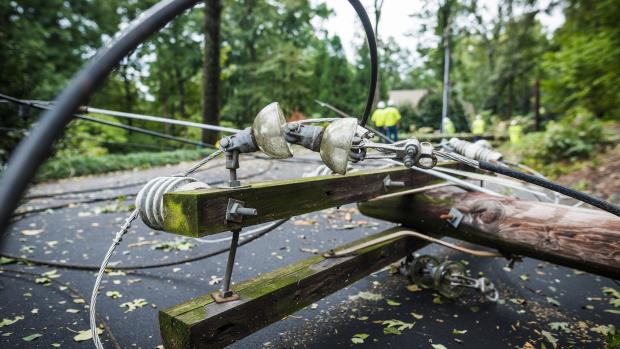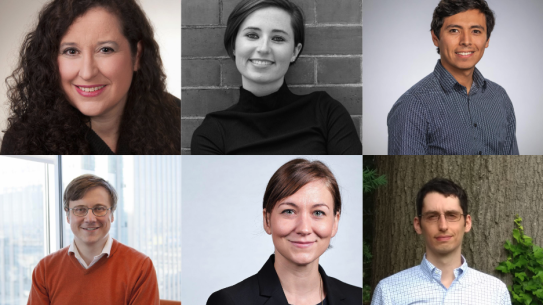Luis Ceferino
-
Visiting Research Professor

Professor Ceferino is a Visiting Research Professor in the Civil and Urban Engineering Department and Affiliated Faculty member at the Center for Urban Science and Progress. He has been an Assistant Professor in the Civil and Environmental Engineering Department at the University of California, Berkeley since 2024. From 2021 to 2023, Prof. Ceferino was an Assistant Professor in the Civil and Urban Engineering Department and the Center for Urban Science and Progress at NYU. Prior to that, he was a Distinguished Postdoctoral Fellow at the Andlinger Center for Energy and the Environment at Princeton University. He completed his graduate studies in Structural Engineering at the John A. Blume Earthquake Engineering Center at Stanford University (M.S. in 2014 and Ph.D. in 2019) and his undergraduate studies in Civil Engineering at the Universidad Nacional de Ingeniería in Lima, Peru (B.S. in 2011).
Research News
New model predicts likely power outages from hurricanes more accurately than conventional predictive techniques
Utility companies are generally well-equipped to handle routine blackouts, but often struggle with extreme weather events like hurricanes.
Conventional hurricane power-outage prediction models often produce incomplete or incorrect results, hampering companies’ abilities to prepare to restore power as quickly as possible, especially in cities that are susceptible to prolonged hurricane-induced power outages.
New research from NYU Tandon School of Engineering may help solve that problem.
By combining wind speed and precipitation data with data about an area’s land use patterns — which reflect variations in power infrastructure between rural and urban areas — and population density — as an indicator of the number of transformers present — researchers are moving towards a more accurate physics-driven hurricane-induced power outage predictive model than techniques currently in widespread use.
Luis Ceferino, a civil and urban engineering (CUE) assistant professor and Prateek Arora, a CUE Ph.D. candidate, presented the research at the 14th International Conference on Applications of Statistics and Probability in Civil Engineering (ICASP 14), held from July 9 - 13, 2023 in Dublin, Ireland.
In May 2023, Natural Hazards and Earth System Sciences published the duo’s paper evaluating the limits of existing power-outage prediction models. The paper discussed those models’ restricted applicability due to reliance on data from specific regions and utility companies; unbounded predictions; difficulties in extrapolating to high wind conditions; and inadequate handling of uncertainties and variance in outage data during extreme weather events.
Compensating for those constraints, the research team is training its model with historical outage data from Hurricanes Harvey (2017), Michael (2018), and Isaias (2020). The model accounts for the nonlinear relationships between input parameters — meaning changes in one variable that do not result in proportional or consistent changes in another variable — and the likelihood of power outages.
In its ICASP 14 paper, the team focused on two key performance indices: the System Average Interruption Frequency Index (SAIFI) and the System Average Interruption Duration Index (SAIDI). SAIFI measures how often customers experience power outages and SAIDI reflects the total time customers spend without power in a year. These indices are pivotal in determining the efficiency and resilience of power systems during extreme weather events.
The research team used probabilistic modeling to compute/obtain the SAIFI and SAIDI for a 10-year return period in New Jersey. It revealed that rural areas face greater likelihood of outages than urban areas, when wind speed is the only damaging factor. The team is continuing to build the model, and upcoming research will incorporate storm surge effects, especially relevant for coastal blackout predictions.
By mapping out the potential scenarios and probabilities of power disruptions, this research project can equip stakeholders including utility companies and regulatory bodies with insights for strategic decision-making. This could include targeted resource allocation, infrastructure upgrades, and even the development of emergency response plans that mitigate the adverse impact of hurricanes on power systems.
Stochastic modeling of solar irradiance during hurricanes
Authors of this research, led by Luis Ceferino, professor of civil and urban engineering and member of the Center for Urban Science and Progress, include Ning Lin and Dazhi Xi of Princeton University.
Despite solar’s growing criticality for electricity generation, few studies have proposed models to assess solar generation during extreme natural events. In particular, hurricanes bring environmental conditions that may drastically reduce solar generation even if solar infrastructure remains fully functional.
In a new paper in researchers present a stochastic model to quantify irradiance decay during hurricanes, using a dataset that analyzes historical data on Global Horizontal Irradiance and 22 landfalling storms from the Atlantic in the North American basin, which reached a category of at least three during their lifetime. The data showed higher irradiance decays for higher hurricane categories and closer to the hurricane center due to optically thick clouds that absorb and reflect light.
Specifically, their model describes the irradiance decay as a function of hurricane category and the distance to the hurricane center normalized by the hurricane size. Their analysis, based on an examination and performance ranking of four irradiance decay functions with varying complexities, demonstrates that the hurricane’s radius of outermost closed isobar performs best as the size metric for normalizing distance.
To showcase the methodology’s applicability, they used it to generate spatiotemporal models of irradiance during storms from genesis to dissipation, based on probable storm behavior in 839 counties in the United States’ southern region. Among the results were that solar-powered electricity generation in Miami-Dade, Florida, can decrease beyond 70% in large regions during a category-4 hurricane even if the solar infrastructure is undamaged.
They found that, furthermore, generation losses can also last beyond three days, and this timeframe will be exacerbated if solar panels become non-functional. The team plans a follow-up study integrating the proposed model with panel fragility functions to offer analysis capabilities for forecasting time-varying solar generation during hurricanes.






